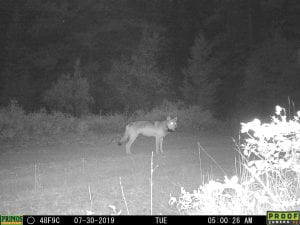Few species have as storied a history with humans as the wolf. From an early age, I was fascinated by their prehistoric domestication and their more recent exterminations and reintroductions. I devoured every book about wolves I could find, and learned about the 1995 reintroduction of wolves into Yellowstone National Park. I found it so fascinating that one species could have such an extensive impact on the landscape. The wolves pushed elk from their comfortable hangouts on river banks, allowing stream flora to build up, and a greater variety of birds to make their homes on the banks. Wolves’ presence went so far as to have a physical effect on the topography of the area, and even brought back the quaking aspen tree from the brink of extinction! Learning these facts made me realize how important wolves are to their ecosystems as a keystone species, and kindled my desire to go out and explore the land they were changing.
As a high school freshman already thinking about a career working with animals, I took part in a wolf tracking summer camp for teenagers run by Wilderness Awareness School, based in Washington State (quite a distance away from my home in New Jersey). At this camp we searched for signs of wildlife during the day on field expeditions, and came back in the afternoon to hit our mobile library to research our observations. Our instructors drilled us in subjects like paw pad morphology, bird markings, and common behaviors of local wildlife. We developed our deductive reasoning skills by transforming our observations on the ground into conclusions about the ecosystem’s structure. Every time we thought we’d found a sign of the area’s resident wolf pack, we’d mark it down on our map. By the end of the camp we had a pretty good idea of its recent activities. We left a trail camera at one of their high activity sites, and captured a video of an adult wolf accompanied by that year’s new litter of pups! Not only was it rewarding to see such elusive animals on our own cameras, but also we were the first observers to confirm that the pack had whelped that year. We were able to provide that information to Washington’s state scientist.
There I also learned about the current challenges that occur when the lives of wolves and people intersect. In Washington and Idaho where wolves travel down from Canada and up from their reintroduction point in Yellowstone, they live on the same land where cattle farmers raise free range beef. Needless to say, this creates a complex intersection of values. Cattle farmers depend on their livestock for their livelihoods. Ranchers and their communities are concerned that wolves will harm that livelihood by killing their cattle instead of elusive deer. Whether it was seeing bumper stickers that said “smoke a pack a day” next to a picture of a wolf’s head, or hearing stories about hunters shouting at the top of the lungs that all wolves need to go to hell, I learned quickly that people felt strongly about this issue. As a future veterinarian and scientist, I understand the need for veterinarians to protect and help both cattle and wolves, supporting farmers and healthy ecosystems.
Before attending this program, I didn’t understand how reintroducing wolves could have any negative impacts. Through my experience at Wilderness Awareness School I came to appreciate the validity of the concerns for reintroduction. Even if reintroducing wolves benefits the overall ecosystem, we cannot ignore the effects they have on ranchers’ livelihoods. Whether it’s protecting a herd of cattle, or treating an injured wolf, veterinarians can help innovate solutions to benefit all animals, wild and domestic.
 Patrick Liu, class of 2024, is a Cornell DVM student. He graduated with a degree in chemistry from Rutgers University in 2020, and plans to pursue internships and residencies after veterinary school. Apart from his love for horses, he has a strong interest in ecological research and wildlife and conservation medicine.
Patrick Liu, class of 2024, is a Cornell DVM student. He graduated with a degree in chemistry from Rutgers University in 2020, and plans to pursue internships and residencies after veterinary school. Apart from his love for horses, he has a strong interest in ecological research and wildlife and conservation medicine.



You must be logged in to post a comment.